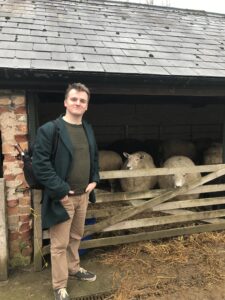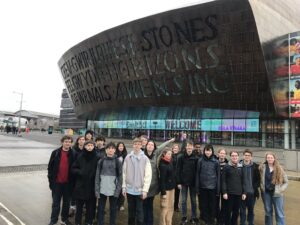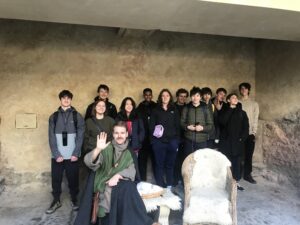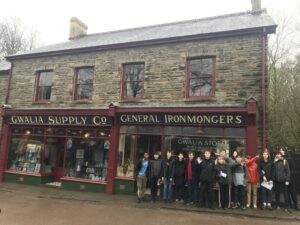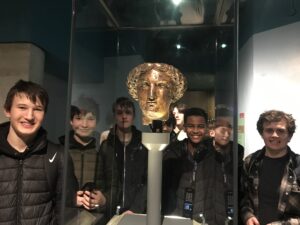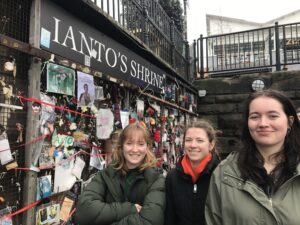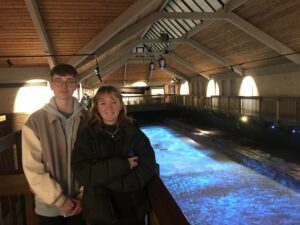Year 11-13 Classics students enjoyed a wonderful outing to Wales over the half term holiday. We visited a panoply of classical sites including Bath, Cirencester, Caerwent, Caerleon Roman baths and military fortress, and Cardiff Bay.
Day One
The first port of call was the Classics department’s spiritual home in Bath, touring around the steamy Great Bath, interacting with the Roman attendants (with whom we are now on first name terms) and reading the ‘defixiones’ (curse tablets) which Romans used to curse their enemies. Sixth formers recreated photos from the pre-Covid 2020 trip to Bath, and ‘cornicen’ Manasseh honked his way through proceedings.
After a spot of lunch, we had a walking tour of Bath, visiting Pulteney Bridge, the Circus and Royal Crescent. We also sauntered around the Parade Gardens, with its lovely view of the River Avon, a pet cemetery and a statue of a young Mozart. We discussed his opera ‘Bastien und Bastienne’, composed when he was only 12 years old, and featuring a younger Mr Morrison in the eponymous role (Bastien, not Bastienne).
We then arrived in Bristol and had an excellent dinner at TGI Friday’s.
Day Two
It was off to Cirencester for the second day, where Mr Morrison and Miss Ferstman led a tour around the Corinium Museum. We saw the ‘Four Seasons’ and Orpheus mosaics, the enigmatic SATOR square and the epitaph to the elusive Bodicacia. We translated several of the inscriptions, including the Septimius stone, where students’ knowledge of Latin was very impressive.
After free time around Cirencester, we travelled to Caerleon, one of only three permanent military fortresses (alongside York and Chester) in Roman Britain. We explored the Roman Baths – complete with atmospheric sound effects and lighting – followed by the military fortress, amphitheatre and museum. The military barracks are the only visible remains in Europe, and gave a good sense of the living space and lifestyle of each ‘contubernium’. This was a gem in the itinerary and invited excellent discussion of the ‘War and Warfare’ module studied by Classical Civilisation students. We discussed the Roman invasion of Isca and the resistance of the Silures, before visiting the summer ‘triclinium’ (dining room) of the museum to interact with the resident ‘matrona’.
Mr Morrison spearheaded a small, devoted crew on a Bristolian ‘Doctor Who’-themed walking tour in which we viewed filming locations from the most recent episode ‘The Giggle’, including the Toymaker’s emporium. This was followed by a short shopping spree at Cabot Circus.
Dinner that evening was at Pizza Express at the Bristol Harbourside. We enjoyed an evening stroll along the riverside, evading one or two of the more rambunctious thermopolia.
Day Three
It was Valentine’s Day – Caerwent was an apt, early start to the day, as it reminded us of our love of Latin. We saw the foundations of Roman country houses, shops, the forum and basilica, and a Romano-British temple. We had a drizzly trudge atop the highest defensive walls in Europe, and students were unswervingly cheerful given the weather.
Thankfully, Jupiter brightened the elements for our next visit to Llandaff Cathedral. We made a katabasis to the haunted cemetery – we looked out for the ghost of the Purple Friar who had drowned in a tragic mulberry juice accident, but instead had to retreat owing to muddy conditions and a talkative dogwalker. We paused at the Cathedral Green used as a filming location during Matt Smith’s era of ‘Doctor Who’, and Maggie deftly translated the Latin inscription on its war memorial.
We then visited St Fagan’s National Museum of History – an open-air museum sited in the grounds of St Fagan’s Castle. This proved an excellent experience and was akin to a life-sized model village, spanning thousands of years of Welsh history. We enjoyed spotting filming locations from ‘Doctor Who’ and visited the farmyard where animal appearances prompted the usual discussion of omens and similes in Virgil’s Aeneid.
Then it was off to Cardiff Bay for an engaging walking tour and film based on the capital and its regeneration throughout the ages. We visited Ianto’s shrine to pay our respects, the Welsh Senedd and the Millennium Centre. Doctor Who locations were ubiquitous, and we had some free time to explore the Bay followed by a final group lunch at Las Iguanas.
Many thanks to all students for their impeccable punctuality and enthusiasm, and to Miss Ferstman and Ms Philp for their help on the trip.
Hwyl fawr,
Mr Morrison, Teacher of Classics
